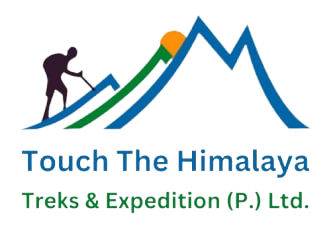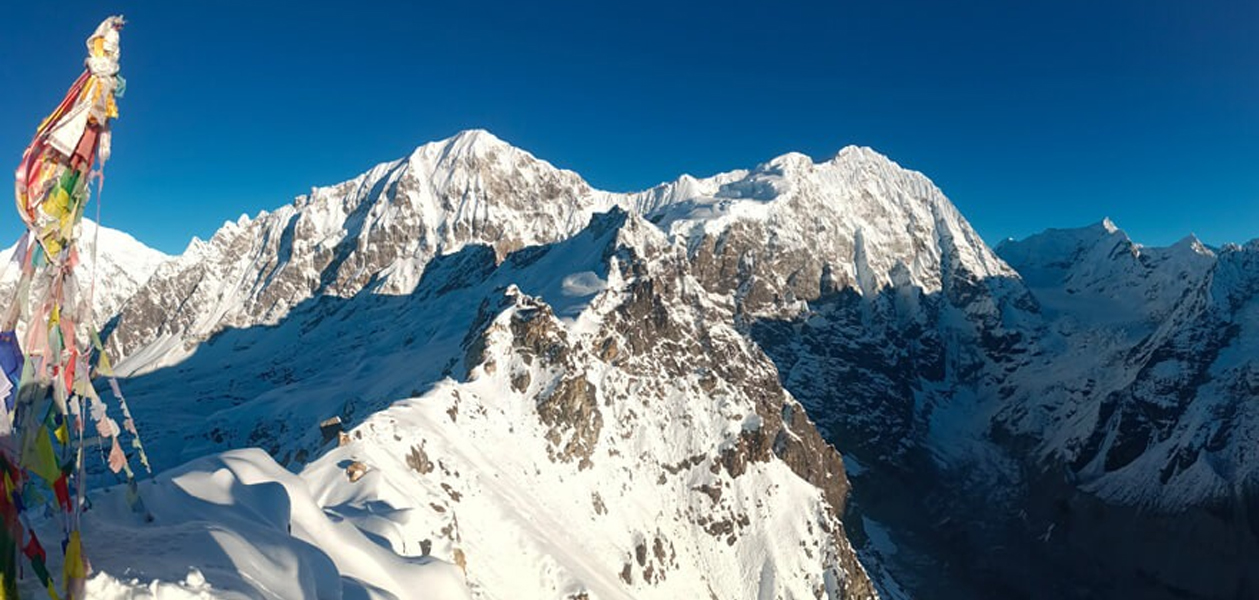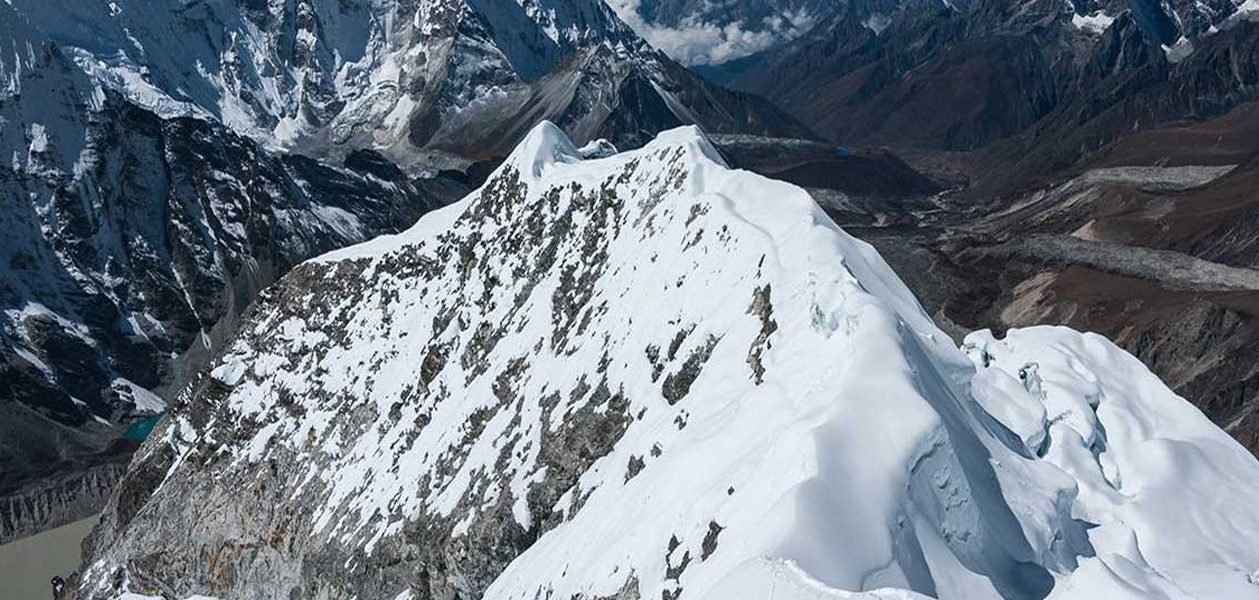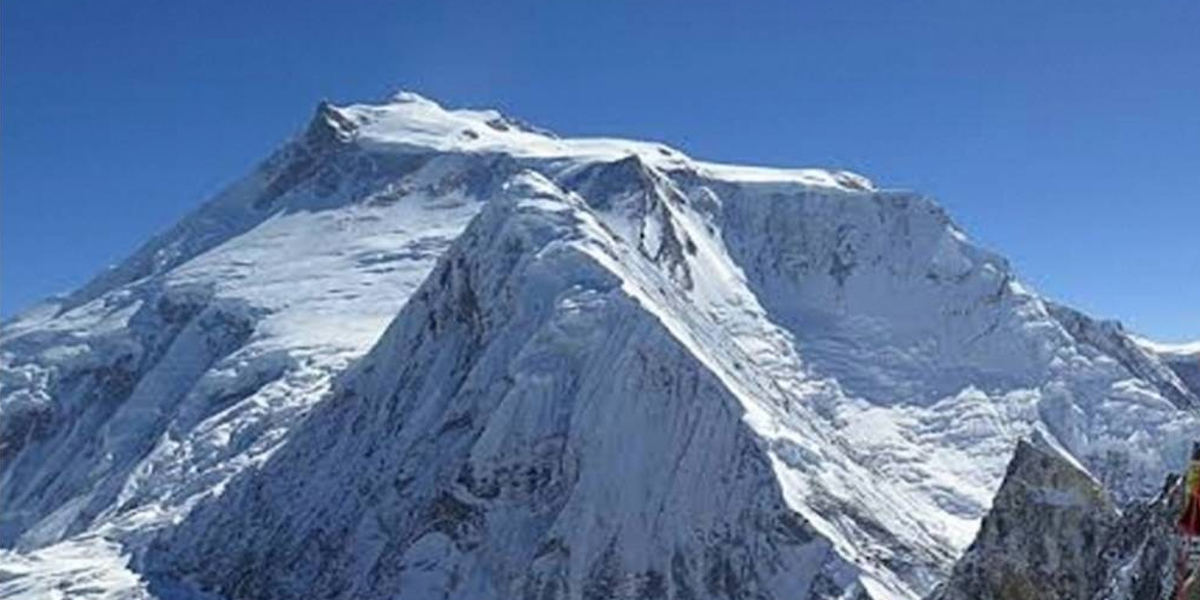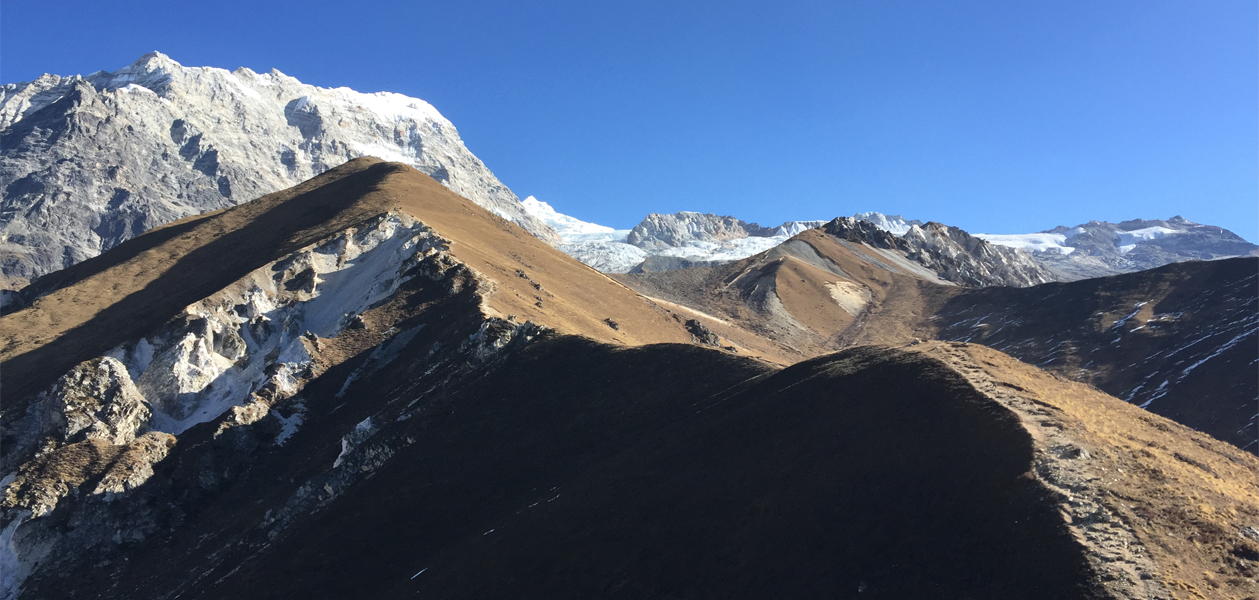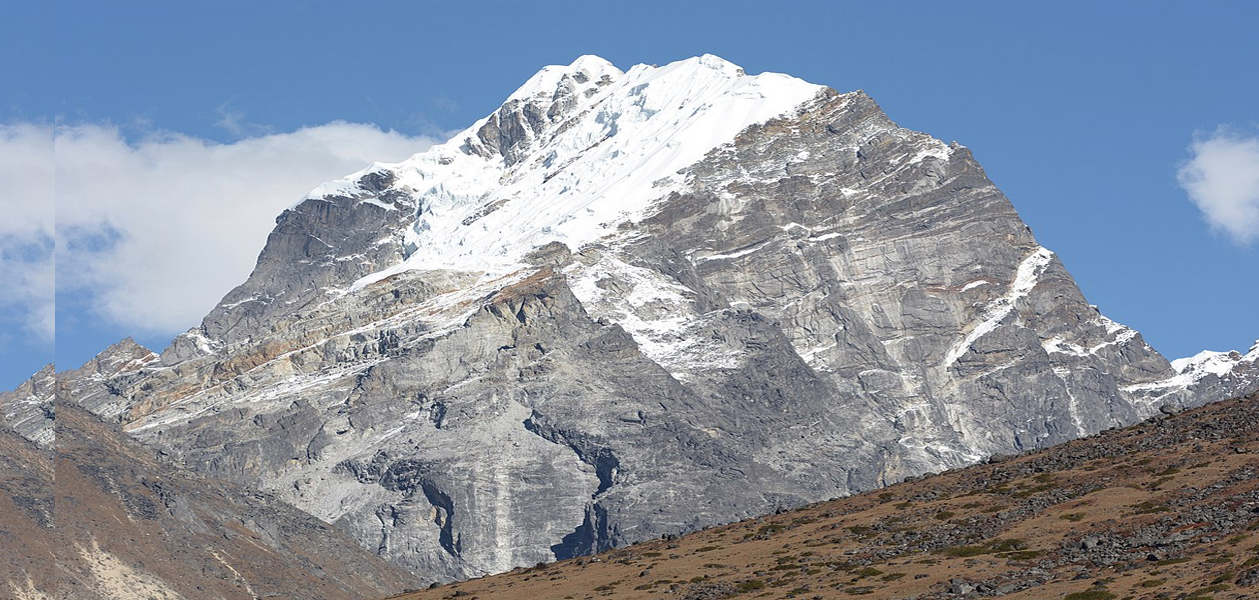Naya Kanga Peak Climbing - 17 Days
Demanding Activities-
Duration
17 Days
-
Activity
Climbing / Expedition
-
DifficultyStrenuous
These treks are the most challenging and require a high level of physical fitness and mountaineering skills. The altitude may go up to 6,000 meters or more, and the terrain can be extremely rugged and steep, with challenging passes and technical sections. These treks often involve mountaineering and require special equipment and permits. Examples of difficult treks in Nepal are the Everest Three Passes Trek, Makalu Base Camp Trek, and the Kanchenjunga Base Camp Trek.
-
Max. Altitude
6189 m
-
Starts
Kathmandu
-
Ends
Kathmandu
-
Group Size
Minimum: 2 pax
-
Best Season
March-May/Sept-Dec
PRICE PER PERSON
- 1 PAX US$1807
- 2 PAX US$1570
- 3 PAX US$1532
- 4 PAX US$1465
- 5-10 PAX US$1447
- 11-20 PAX US$1432
- Highlights
- Itinerary
- Route Map
- What Included / Excluded
- Dates & Availability
- Additional Information
TRIP HIGHLIGHTS
- Breathtaking panoramic views of the surrounding Himalayan peaks, including Langtang Lirung, Shishapangma, Gangchempo, Dorje Lakpa, and Langshisa Ri.
- Experience the unique culture and lifestyle of the local people.
- Thrilling trek through diverse landscapes, including dense forests, lush valleys, and high alpine meadows.
- Cross suspension bridges, traverse rugged terrains, and encounter various flora and fauna along the way.
- Involves steep snow slopes, icy sections, and some sections of rock scrambling.
- Langtang National Park, where you can spot wildlife such as red pandas, Himalayan tahrs, and various bird species.
- Encounter traditional Tamang and Sherpa villages.
- Breathtaking sunrise and sunset views from the summit create lifelong memories.
- Camping in remote and pristine locations, under starry skies.
Naya Kanga Peak Climbing Overview
Naya Kanga Peak, also known as Ganja La Chuli, is a popular trekking peak located in the Langtang region of Nepal. Standing at an elevation of 5,844 meters (19,164 feet), it offers a thrilling climbing experience for mountaineers. The mountains in Nepal and Tibet can still be seen in stunning detail from this area, which is more accessible than others.
From Naya Kanga’s summit, you can see Shisapangma (8013m), Langtang II (6571m), Pemthang Kapro Ri (6830m), Langtang Lirung (7425m), Langshisa Ri (6370m), Pemthang Ri (6836m), and Langtang Lirung (7425m) in addition to a number of other magnificent mountains in Nepal and Tibet.
The climbing journey to Naya Kanga Peak typically begins with a scenic drive from Kathmandu to Syabrubesi, followed by a trek through the beautiful Langtang Valley. The trek takes you through lush forests, terraced fields, and traditional Tamang and Sherpa villages, providing an opportunity to immerse yourself in the local culture and witness their way of life.
As you trek through the Langtang Valley, you’ll come across the village of Lama Hotel. This is a scenic resting point surrounded by lush forests and offers a serene environment to relax and enjoy the natural beauty of the region. Continuing along the trail, you’ll reach Langtang Village, one of the major settlements in the region. Langtang Village was severely affected by the 2015 earthquake, but it has been rebuilt. Take the opportunity to interact with the friendly locals and learn about their way of life.
Further up the trail, you’ll arrive at Kyanjin Gompa, a Buddhist monastery and the last village before heading towards Naya Kanga Base Camp. Explore the monastery, enjoy the panoramic mountain views, and take in the tranquility of the surroundings. Once you leave Kyanjin Gompa, you’ll make your way towards Naya Kanga Base Camp. This is where climbers set up their camps, rest, and prepare for the summit push. The Base Camp offers stunning views of the surrounding peaks and the glacier-covered landscape.
After acclimatization at the Base Camp, you’ll ascend further to High Camp. This campsite is strategically located closer to the summit, allowing climbers to make their final preparations before the summit bid. The highlight of the expedition is reaching the summit of Naya Kanga Peak. The climb involves navigating snow slopes and technical sections. Upon reaching the summit, you’ll be rewarded with breathtaking panoramic views of the Himalayas and a sense of accomplishment.
Table of Contents
Ecology of the Langtang Region during the Naya Kanga Peak Climbing:
The Langtang region is known for its diverse biodiversity. As you trek towards Naya Kanga Peak, you’ll pass through beautiful forests of rhododendron, oak, pine, and bamboo. The region is home to various wildlife, including Himalayan black bears, red pandas, musk deer, snow leopards, and numerous bird species. The vegetation varies with the altitude, ranging from lush forests in the lower regions to alpine meadows and rocky terrain at higher elevations.
Best Climate for climbing the Naya Kanga Peak:
The climate in the Langtang region, including Naya Kanga Peak, varies depending on the season and altitude. Spring (March to May) and autumn (September to November) are considered the best seasons for climbing Naya Kanga Peak. During these months, the weather is generally stable, with mild temperatures and clear skies. Daytime temperatures at lower elevations range from 10°C to 20°C (50°F to 68°F), while temperatures at higher altitudes can drop below freezing. However, it’s important to be prepared for temperature fluctuations and possible weather changes, including rain and snowfall, especially at higher elevations.

Difficulty Level of Naya Kanga Peak Climbing:
Naya Kanga Peak climbing is considered a moderately challenging trekking peak in Nepal. It requires a good level of physical fitness and previous trekking experience. The climb involves some technical sections, including steep ascents, glacier crossings, and potentially icy terrain. Basic mountaineering skills, such as the use of crampons, ice axes, and rope techniques, are required. Altitude sickness can also be a concern, so proper acclimatization and a gradual ascent are crucial. Overall, Naya Kanga Peak climbing is suitable for experienced trekkers looking to take their mountaineering skills to the next level.
Preparing yourself for Naya Kang Peak Climbing
Peak climbing is a demanding activity and Naya Kang Peak Climbing although popular can be difficult to accomplish without proper training and conditions. The preparations, it’s benefits, and methods are listed below:
Training Regimen
- Start Early: Begin training at least two to three months before the trek to ensure both physical and mental preparedness.
- Focus Areas: Concentrate on building endurance, strength, stamina, and mental readiness to handle the challenges of the climb.
Cardiovascular Workouts
- Types of Activities:
- Cycling
- Running
- Jogging
- Paddling
- Hiking
- Benefits:
- Increased Oxygen Levels: These activities help your body acclimate to the lower oxygen levels at high altitudes.
- Improved Flexibility: Aerobic exercises enhance overall flexibility, which is crucial for the varied terrain of the Himalayas.
- Reduced Altitude Sickness Risk: Regular cardio workouts can lower the chances of experiencing altitude sickness.
- Lower Injury Risk: Strengthened muscles and improved endurance help in reducing the risk of injuries and muscle strain during the trek.
Physical Conditioning
- Purpose: To enhance your physical ability to endure long hours of trekking.
- Training Goals:
- Build endurance for 5-6 hours of trekking each day in challenging terrains.
- Increase overall strength and stamina.
- Diet:
- Carbohydrates and Protein: A diet rich in these nutrients supports muscle building and provides the necessary energy for trekking.
Mental Preparation
- Importance: Mental readiness is key to maintaining motivation and a positive outlook during the trek.
- Methods:
- Explore Similar Terrains: Practice trekking in hilly landscapes to simulate the conditions you will face.
- Seek Advice: Talk to experienced trekkers to gather tips and insights.
- Research: Conduct thorough research on Naya Kanga Peak Climbing to understand what to expect, which can help in mental preparation and reduce anxiety.
Duration of the Naya Kang Peak climb:
The duration of the Naya Kanga Peak climb typically ranges from 18 to 20 days, depending on the specific itinerary and acclimatization needs. This duration includes the trek to and from the peak, acclimatization days, and the summit attempt. It’s important to allocate enough time for proper acclimatization to minimize the risk of altitude-related illnesses. The duration also allows for flexibility in case of adverse weather conditions or the need for additional rest days. It’s recommended to consult with experienced trekking companies or guides to determine the most suitable itinerary for Naya Kanga Peak climbing.
Types of equipment needed for climbing Naya Kang Peak:
When getting ready to climb Naya Kang Peak, it’s crucial to think about the gear you’ll need. For clothing, consider your comfort with wearing unwashed items compared to how often you like to change into fresh ones. Make sure to pack plenty of warm clothes appropriate for cold conditions, keeping in mind the unpredictable nature of mountain weather, especially if you plan to reach the summit. Also, remember that you can conveniently buy all the necessary equipment in Kathmandu.
· Duffel Bag
- Choose a waterproof duffel bag with a TSA lock and sturdy strap.
- Capacity: 100 to 140 liters.
· Sleeping Bag
- Rated for temperatures as low as -20°C.
- Consider bringing a liner for extra warmth.
· Daypack Bag
- Capacity: 30 to 40 liters.
- Should have side pockets for wallets, cameras, water bottles, and jackets.
- Use a Camelbak in cold weather to prevent water from freezing.
· Water Bottles
- Carry two water bottles.
- Include a Nalgene bottle for hot water.
- A Camelbak for easy access to water.
· Upper Body Clothing
- Synthetic t-shirts for trekking.
- Wind shirt.
- Merino wool t-shirts.
- Insulated jacket for climbing.
- Fleece gloves and insulated gloves.
- Buff for dust protection.
- Sunglasses and sun hat.
- Fleece hat and rain gear.
· Footwear
- Trekking shoes with good grip and ankle support.
- Lightweight slippers for guest house comfort.
- Cotton hiking socks, hiking pants, fleece trousers, waterproof pants.
· Other Essentials
- Water treatment supplies.
- Fast-drying camp towel and body wipes.
- Toiletries and sunscreen.
- Earplugs, mobile phone, and diary.
- Chargers with adapters, camera.
- Medical kit and headlamp.
- Hand sanitizer, trekking sticks.
- Pocket knife and pee bottle for nighttime use.
· Climbing Support
- Our company provides accommodations, food, guides, and climbing equipment.
- Additional climbing gear is available for rent at competitive prices.
· Climbing Gear
- Synthetic insulated pants, shell jacket.
- Insulated snow pants, and thick climbing socks.
- Mountaineering boots, snow goggles.
- Climbing harness, crampons, ice ax.
- Belay device, climbing helmet.
- Locking and non-locking carabiners, ascender.
- Gaiters and mountaineering gloves.
Safety for Naya Kanga Peak Climb:
Safety is of utmost importance during Naya Kanga Peak climbing. It is highly recommended to climb with an experienced guide or a reputable trekking agency. They will provide necessary safety equipment, guidance, and support throughout the journey. It is important to follow their instructions, maintain proper acclimatization, and be prepared for any changes in weather conditions.
Accommodation during the Naya Kanga Peak Climb:
When climbing Naya Kanga Peak, you’ll experience various types of accommodations and dining options, ranging from teahouses at lower altitudes to camping and high camps at higher elevations. Here’s what to expect for food and lodging during your climb:
Teahouses (Lower Elevations)
- Locations: At the beginning of your trek in the Langtang region, especially in lower areas, you’ll find teahouses in villages such as Syabrubesi, Lama Hotel, and Langtang Village.
- Lodging: Teahouses offer simple but comfortable lodging for trekkers and climbers.
- Rooms: These can be private or shared, with basic beds, blankets, and pillows.
- Facilities: Shared bathrooms with basic amenities are common, and some teahouses provide hot showers and electricity, often powered by solar energy.
- Menu: Teahouses serve a variety of meals, including local Nepali and Tibetan dishes as well as international options like pasta and pancakes.
- Atmosphere: They offer a cozy environment where you can interact with other trekkers and climbers.
Camping (Higher Elevations)
- Transition: As you climb higher, you’ll switch from staying in teahouses to camping, especially for the final push to the summit and beyond.
- Camp Sites: These are carefully chosen for their protection from the elements and their closeness to the climbing routes.
- Lodging: You’ll stay in expedition tents, with sleeping bags and sleeping pads provided by your trekking agency or expedition organizer.
- Meals: A dedicated camping team, including a cook and support staff, will prepare meals at the campsite.
- Nutrition: The food is designed to give you the energy and nutrition needed for the climb, featuring a mix of local and international dishes.
- Special Diets: If you have special dietary needs, let your trekking agency know in advance so they can accommodate you.
High Camps:
- Purpose: During the summit push, high camps are established at even higher altitudes.
- Lodging: Accommodation at high camps typically involves smaller tents for shelter during the final stages of the climb.
- Strategic Placement: These camps are placed strategically to minimize the distance to the summit and maximize safety during the ascent.
Accommodations during the Naya Kanga Peak climbing expedition will start with teahouses in the lower elevations and move to camps and high camps at higher altitudes. Teahouses provide basic yet comfortable lodging and a variety of meals, offering a chance to meet fellow trekkers. As you ascend, camping becomes necessary, with tents and meals provided to ensure you have the energy and comfort needed for the climb. High camps are crucial for the final push to the summit, offering shelter and strategic placement for safety and efficiency. Proper planning and communication with your trekking agency will help ensure a safe and enjoyable experience.
Meals:
“Touch the Himalayas” ensures that trekkers are provided with meals throughout the Naya Kang Peak climbing. We offer three meals a day: breakfast, lunch, and dinner. These meals are typically served in the teahouses or lodges along the trekking route. The food options include a variety of local and international dishes, such as rice, noodles, soups, vegetables, lentils, meat (if available), bread, and tea/coffee. The meals are designed to provide sufficient energy and nutrition for trekkers undertaking the challenging climb.
Guides for climbing Naya Kanga Peak:
- Hiring Skilled Local Guides
Engaging the services of skilled local guides is highly recommended for anyone planning to climb Naya Kanga Peak. These professionals are invaluable for ensuring safety, providing navigation, and sharing local knowledge that can enhance the overall climbing experience. Local guides are familiar with the terrain, weather patterns, and potential hazards, which allows them to make informed decisions that can significantly reduce the risk of accidents.
One of the key roles of a guide is to assess weather conditions accurately. In mountainous regions, weather can change rapidly and unpredictably. Guides have the experience to interpret weather signals and decide when to advance or when it’s safer to wait. This expertise is crucial for avoiding dangerous situations that could arise from unexpected storms or other adverse weather conditions. - Monitoring and Managing Altitude Sickness
Another critical responsibility of local guides is monitoring climbers for symptoms of altitude sickness. Altitude sickness can affect anyone, regardless of their fitness level, and it can escalate quickly if not managed properly. Experienced guides are trained to recognize the early signs of altitude sickness and can take appropriate actions, such as adjusting the pace of the climb, ensuring proper hydration, or descending to a lower altitude if necessary. This vigilance helps protect climbers from the severe consequences of high-altitude illnesses. - Technical Skills and Physical Demands
Climbers who have prior hiking or mountaineering experience are generally better prepared to handle the technical challenges and physical demands of climbing Naya Kanga Peak. However, even experienced climbers can benefit from the knowledge and support of professional guides. The climb requires a combination of technical skills, such as using climbing equipment and navigating difficult terrain, as well as effective altitude management and physical fitness. Guides can provide instruction and support in these areas, making the climb more manageable and increasing the chances of a successful summit. - Role of Porters
In addition to guides, hiring porters can significantly enhance the climbing experience. Porters are responsible for carrying heavy gear and supplies, which allows climbers to focus on the ascent without the added burden of a heavy backpack. This support is particularly important in high-altitude climbs, where conserving energy is crucial. Porters, like guides, are usually well-acquainted with the region and can contribute to the safety and efficiency of the expedition.
- Preparation and Training
Adequate preparation and training are essential for a safe and successful Naya Kanga Peak climb. Climbers should engage in a training regimen that builds endurance, strength, and stamina. Cardiovascular workouts, strength training, and mental preparation are all important components of this training. Additionally, climbers should educate themselves about the specific challenges of Naya Kanga Peak, including the technical skills required and the potential risks. - Thorough Research and Specialist Guidance
Before embarking on this challenging adventure, climbers should thoroughly research the climb. This includes understanding the route, knowing what equipment is needed, and being aware of the weather patterns and potential hazards. Seeking guidance from specialists, such as experienced climbers or professional guiding companies, can provide valuable insights and tips that can make a significant difference in the climb’s success and safety.
Climbing Naya Kanga Peak is a demanding endeavor that requires a blend of technical abilities, altitude management, physical fitness, and good instruction. The assistance of professional guides and porters, along with thorough preparation and training, are critical for a safe and successful climb. By taking these steps, climbers can enhance their chances of reaching the summit and enjoying a rewarding and memorable experience.
Permit for climbing Naya Kanga Peak:
“Touch the Himalayas” assists trekkers in obtaining the necessary permits for Naya Kanga Peak climbing. These permits may include the Langtang National Park Entry Permit and the Climbing Permit for Naya Kanga Peak. We handle the paperwork and guide you through the permit application process to ensure all necessary permits are obtained before the expedition begins. These permits are essential to comply with the local regulations and support the conservation efforts in the region.
Itinerary
Welcome at Tribhuvan International Airport, then transfer to your hotel.
A full day sightseeing tour of Kathmandu
Drive to Syaphru Bensi at 1503m.
Trek to Lama hotel at altitude of 2410m
Trek to Langtang at altitude of 3430m
Trek to Kyanjin Ghumba at altitude of 3830m
Acclimatization hike to Kyanjin Ri at altitude of 4550m
Acclimatization hike to Tsergo Ri located at 4850m
Climb to Naya Kanga base camp located at 4500m
Climb to Naya Kanga high Camp located at 4900m
Climb Naya Kanga located at 5844m and return to base camp
Trek to Kyanjin Ghumba located at 3800 m
Trek to Lama Hotel located at 2410m
Trek to Syaphru Bensi at altitude of 1600m
Drive to Kathmandu and farewell-celebration dinner
Rest Day in Kathmandu
Final departure for the airport
Itinerary Note:
This itinerary is just the guide line, it can be changed (longer or shorter) as per our client's wishes, fitness, ground reality and weather condition. If you're not satisfied or have an alternative plan please feel free to discuss it with us By Clicking :- ASK QUESTION or COSTOMIZE YOUR TRIP.What's Included / Excluded
Cost Incluldes
- Airport pick up and drop off by Car, jeep, Hiace or Bus. Depends on the number of arrives.
- Complimentary welcome or farewell dinner according to the suitability of our client’s time.
- Beginning two nights stay on arrival in Kathmandu in tourist standard hotel with breakfast included (twin share basis)
- Internal transport and flight within Nepal as per the itinerary
- All necessary trekking and area permit & fees, (National Park area special permit and TIMs cards).
- OPTIONAL: Three meals a day during the trek (If of required, we provide meal during the trekking)
- OPTIONAL: All accommodation during trek (If of required we arrange all accommodation)
- An experienced, English-speaking, government-licensed, first aid trained trekking guide and assistant guide (5 trekkers: 1 assistant guide)
- An expert local porters (2 trekkers: 1 porter)
- Duffel bag, (to be returned after trip completion), complementary trekking maps. If needed down jacket and sleeping bag will be provided in rent.
- Staff costs including their salary, insurance, Equipment, transport, food and accommodations
- Rescue arrangements if necessary.
- Basic First-aid kit (carried by trekking guide)
- All government and local taxes for Trekking, Agency service charge and government tax/vat.
- Achievement Certificate
Cost Excludes
- International airfare and Nepal visa fee.
- Lunch and Dinner in Kathmandu
- Extra night accommodation in Kathmandu because of early arrival, late departure, early return from mountain (due to any reason) than in the scheduled itinerary
- Personal insurance which covers medical, emergency evacuation, loss or theft of property.
- Personal gears and equipment.
- Personal expenses such as laundry, hot showers, battery charging, Wifi, etc
- Entry fees and costs in sightseeing (temples, monasteries, etc)
- Tips and gratitude provided to guide and porter.
Fixed Departure
Can't find trip as your Schedule Date?
- Above mentioned departure dates “AVILABLE”‘ means these dates are currently open for bookings for the particular Trek. If the mentioned dates are not suitable with your preferred date, you can make your own private trip by clicking the box billow in the bottom.
- A date “GUARANTEED” means that we give guarantees that the costumers will be able to start theirs trek on the specified date, regardless of whether the seats are fully booked or not.
- “LIMITED”‘ Status refers to a type of seats booking for the trek, that has been certain seats available to book
- In the status, “CLOSED” means that the Trekkers seats are fully booked and there are no more seats available for new booking. Trekkers may be put on a waitlist for a chance to get a seat if there are cancellations unless your are requested to plan your own private trip by clicking the box billow in the bottom.
Additional Information
All the trip grading can be view here.
If you have any confusion for booking process please visit our booking process.
Manaslu Circuit Trek [ 1 Reviews ]
Amazing trekking 2016
November 10, 2016Amazing trekking
It was an amazing experience into the Himalayas. You can feel confortable and safe with this experienced agency. They managed very well our permits and they have a very professional team of guides and porters
Date of experience: October 2016

